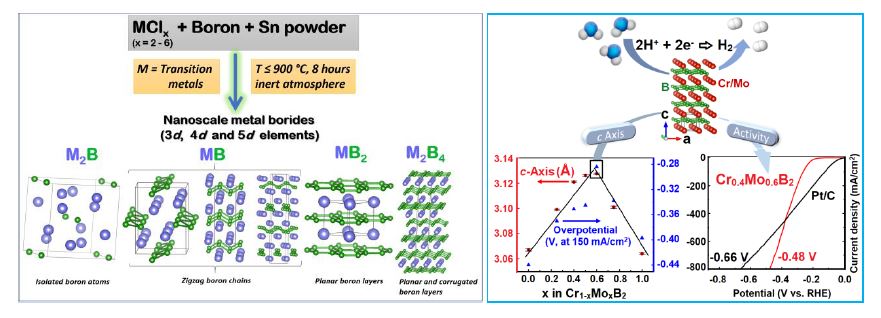Video Article Open Access
Designing Boride Electrocatalysts for Hydrogen Evolution
Hyounmyung Park, Raja P. Jothi, Eunsoo Lee and Boniface P.T. Fokwa*
Department of Chemistry and center for catalysis, University of California, Riverside, CA 92521, USA
Vid. Proc. Adv. Mater., Volume 1, Article ID 2020-0803 (2020)
DOI: 10.5185/vpoam.2020.0803
Publication Date (Web): 05 Aug 2020
Copyright © IAAM
Graphical Abstract

Abstract
The electrolysis of water is considered as a clean mean for large scale hydrogen gas production. However, this large-scale production is still hindered by the high cost and scarcity of noble metal catalysts such as Pt. Recently, non-noble metal materials have emerged as highly active electrocatalysts (AlB2-type) for the hydrogen evolution reaction (HER) to produce hydrogen. Our recent research found that a‑MoB2 [1] exhibits high HER activity. In addition, density functional theory (DFT) calculations show that several surfaces of MoB2 are active and the optimum evolution of H2 occurs on the graphene-like B-terminated {001} surface. Furthermore, DFT and experiments demonstrate that a‑MoB2 is more HER active than b-MoB2 [2], due to the presence of 50% more graphene-like boron layers in the former It was recently also found that FeB2 is highly active for overall water splitting in basic solution. However, TiB2 is not as active as MoB2 for HER. To examine the distinct activities of metal diboride as HER electrocatalysts and how the metals could affect the graphene-like boron layer, DFT was applied to investigate the H-surface adsorption process on MB2 (M = Ti, Zr, Hf, V, Nb, Ta, Cr, Mo, W). Our results indicate that the H-surface binding energy decreases as the electronegativity of the metal increases. Therefore, the electron transfer between metal and boron is one of the key parameters to control the HER activity of MB2. Using a recently developed synthesis, [3] we were able to synthesize most of the above-mentioned diborides at the nanoscale. VB2 behaves similarly to MoB2, thus it was predicted by DFT to be a highly active HER catalyst candidate and confirmed by experiments. Subsequently, an unexpected boron-chain dependency of the HER activity was discovered in vanadium borides, that enabled not only the prediction of the HER activity of unstudied V2B3 but also those of other hypothetical “VxBy” were predicted using an exponential equation that predicts the overpotentials of known and hypothetical VxBy phases containing at least a boron chain. [4] We have also recently discovered an unexpected lattice parameter-dependency on HER of ternary variants with the AlB2-type structure that has enabled an excellent boride HER electrocatalyst that outperforms Pt/C at high current density. [5]
Keywords
Hydrogen evolution, Borides, Electrocatalysis, AlB2-type, Current density.
Acknowledgement
We acknowledge funding from UC Riverside and NSF.
References
Biography
Boniface P. T. Fokwa obtained his BS and MS from University of Yaounde I (Cameroon), his PhD from Dresden University of Technology (Germany) in 2003 and his Habilitation from RWTH Aachen University (Germany) in 2010. After working for four and half years as Heisenberg Fellow at RWTH he accepted an Assistant Professor position at University of California, Riverside in 2015 and was promoted to Associate Professor with tenure in 2018. He is a recipient of several awards including a DFG postdoctoral fellowship (2004-2006), a Heisenberg Fellow Award (2011-2015, from the German research foundation, DFG) and an NSF CAREER Award (2017-2021). He was a visiting scientist at the University of Auckland (New Zealand, 2011), at Cornell University (USA, 2012) and a visiting Professor at the University of California, Los Angeles (USA, 2014-2015). He serves as Section Editor for Encyclopedia of Inorganic and Bioinorganic Chemistry. His research group combines experimental and computational methods to rationally design materials for energy-related applications such as magnets, superconductors, and catalysts. He has co-authored a book, a book chapter and 115 peer-reviewed publications so far.
Video Proceedings of Advanced Materials

Upcoming Congress



